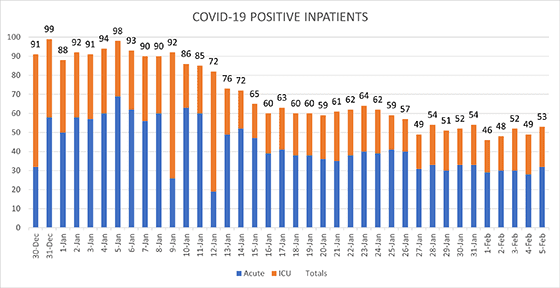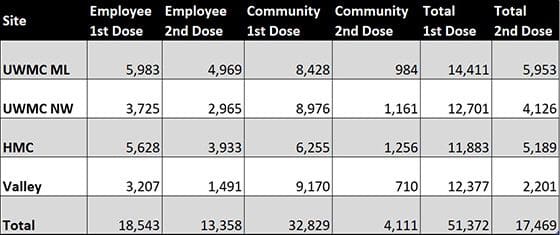Lots of activity this week as King County and the Puget Sound Region moved into Phase 2 of the state’s Healthy Washington – Roadmap to Recovery reopening plan. Phase 2 allows for additional indoor activities at 25% capacity, including dining, fitness, worship services and more. This is a result of COVID-19 cases decreasing locally and increased capacity within hospitals.
Backing that up are the updated forecasts from the UW Medicine Institute for Health Metrics and Evaluation. According to those data, the “winter” peak of infection in Washington state is now behind us, which is great news. At the same time, we must remain cautious as activities re-open and we learn about the more transmissible virus variants that are circulating in our state.
Having vaccines available — and more in development — is a promising path toward ending the pandemic, despite the challenges we are seeing from new coronavirus variants. Our UW Medicine vaccine teams continue to work tirelessly to ensure equitable and safe distribution of vaccinations to the community, as supply is available. Please consult the Frequently Asked Questions About COVID-19 Vaccines for Employees for up-to-date vaccine information.
It is critical as a community and region that we approach the progress we’re experiencing in our state with cautious optimism. Although entering Phase 2 is an encouraging step for Western Washington, staying in it is dependent upon COVID-19 activity continuing to trend downward. As repetitive as it feels one year in, masking, physical distancing and avoiding large gatherings remain the best methods for controlling further spread of the virus.
Today’s update includes:
• Local/National/Global Epidemiology
• Vaccination Summary
• Employee Quarantine Housing
UW Medicine COVID-19 Activity Summary

Local/National/Global Epidemiology
King County: Public Health – Seattle & King County is reporting 77,841 total cases and 1,279 deaths as of Thursday, Feb. 4. The number of new positive tests is currently at 187/14 days/100,000 people. The effective reproductive (Re) number was estimated to be 0.5 (estimate range: 0.2 – 0.7).
Washington: The Department of Health reports 302,782 cases and 4,416 deaths as of Wednesday, Feb. 3. Of the 4,670,815 people who have been tested, 6.5% have been positive.
United States: The Centers for Disease Control and Prevention reports 121,212 new cases, 26,398,337 total COVID-19 cases and 449,020 deaths as of Thursday, Feb. 4.
Global: The WHO COVID-19 Dashboard reports 104,370,550 confirmed COVID-19 cases and 2,271,180 deaths as of Feb. 5.
UW Medicine Vaccination Summary as of Feb. 4

*Total Doses Given: 68,841. Site numbers represent doses administered, not the number of people who have been vaccinated and work at each site.
Employee Quarantine Housing
A high-risk exposure to COVID-19 can create additional stress for staff and faculty who may not be able to effectively quarantine in their homes or isolate from family members. To help with this, the University of Washington is now offering some options through the UW Special Housing Program and the UW Guest Housing Program for employees who find that they need to isolate or quarantine away from their homes.
Please note that all costs for temporary housing for COVID-19 are the responsibility of each employee. We encourage all who meet the eligibility requirements for income and other thresholds to apply to the Employee Emergency Fund (EEF) to cover these costs. This fund also supplies childcare grants and support for eligible employees who are experiencing a temporary, unexpected and critical financial hardship due to COVID-19. If you are required to isolate and can’t do so safely at home because a family member tested positive or was a close contact, then the cost of temporary housing may qualify as an eligible hardship. See more information about the housing programs here.
A common topic I’m reading about and hearing discussed lately is double masking. Is it necessary? What is the best form of double masking? What’s most important is that everyone is wearing a well-fitting, comfortable mask made of more than one layer of fabric when they are around anyone who is not in their household. As former CDC director Dr. Tom Frieden said recently, “If you wear a mask and I wear a mask, that’s double masking, protecting both of us.”
Thank you, as always, for getting vaccinated when it’s available to you, for masking up and for always helping to keep our community safe and healthy.
Sincerely,
John Lynch, MD, MPH
Medical Director, Infection Prevention & Control
Associate Medical Director, Harborview Medical Center
Division of Allergy & Infectious Diseases, UW School of Medicine

